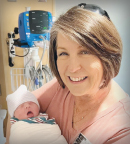About 8 years ago, I was just a few years into menopause when I noticed blood in my urine. It wasn’t accompanied by pain, frequent urination, or any other troubling symptoms, so initially I wasn’t too concerned. But when I started passing pieces of tissue, I became alarmed and made an appointment with my gynecologist. She performed a dilation and curettage procedure to remove any abnormal tissue that might be causing the condition, and I remained symptom-free for nearly a year. But in December 2015, the bleeding started again. I had just relocated to northwest Florida, and it took several months to find a new physician and get an appointment for a checkup.
After an examination, the clinician said I had a urinary tract infection and prescribed antibiotics for 6 weeks, which failed to resolve the problem. I was then referred to a urologist for additional evaluation. A computed tomography (CT) scan of my abdomen and bladder found a large mass in my bladder. “Don’t worry,” said the urologist. “Women don’t get bladder cancer. The mass is probably benign.” Looking back on that conversation now, I’m sure it was his way of keeping me from worrying, but his words didn’t help.
My sister-in-law had been diagnosed with bladder cancer a few years earlier, and after seeing what she had gone through coping with the disease, I was scared. Prior to my sister-in-law’s diagnosis, there was no history of cancer in my family, so the disease hadn’t been a direct source of concern until now. I have never smoked and have always lived a healthy lifestyle. Now, I was in unfamiliar territory.

Lesa Kirkman with her grandson, Wesley, born on February 18, 2024.
Getting My Life Back
Surgery was scheduled to remove the mass, but after one surgical date and another were cancelled, I decided to travel from Florida to a major cancer institution—The University of Texas MD Anderson Cancer Center in Houston—for the surgery and, finally, a diagnosis. I knew enough about cancer; if that’s what I had, my best chance for survival was immediate treatment.
The news wasn’t what I wanted to hear. My surgical oncologist performed a transurethral resection of bladder tumor, in July 2016, and the biopsy results showed I had stage T1 high-grade noninvasive papillary bladder cancer. Even though I knew this diagnosis was a possibility going into the surgery, it was still shocking to hear. I had a second surgery a couple of months later to remove additional tumors and was prescribed the standard of care for early-stage bladder cancer: bacillus Calmette-Guérin (BCG) therapy. Despite continuing the treatment every 3 months over 2 years, new tumors kept appearing following more surgeries.
Finally, my oncologist told me what I was totally unprepared to hear: BCG was no longer effective, and my best option for a cure was a radical cystectomy. I was just 56 years old and did not want to live the rest of my life with an ileal conduit.
I asked if there was another option for me, and my oncologist suggested a phase III clinical trial investigating intravesical nadofaragene firadenovec-vncg, a novel gene therapy for patients who have become unresponsive to BCG. I was among the last patients accepted into the study and started on the trial in 2018.
Prior to receiving nadofaragene firadenovec, all remaining tumors in my bladder were surgically removed, and the cancer has not recurred since the therapy was started. In 2021, the therapy was discontinued. Gene therapy put me in remission, and I’ve remained in remission with no evidence of disease for the past 3 years. I owe it all to research.
(Editor’s Note: On December 16, 2022, the U.S. Food and Drug Administration approved nadofaragene firadenovec for adults with high-risk, BCG-unresponsive, non–muscle-invasive bladder cancer with carcinoma in situ with or without papillary tumors.1)
Making a Contribution to Research
Except for some fatigue and muscle and joint pain while I was on the treatment, which have since mostly abated, I have not had any long-term side effects from the therapy, and my quality of life is great. I play tennis three or four times a week and go for long walks with my daughter several times a week; my husband and I have resumed our globe-trotting travel schedule.
I’m grateful every day for the research that has given me back my life and for the remarkable care I received from my oncology team. I’m also indebted to all the patients who enrolled in the earlier phases of the clinical trial for nadofaragene firadenovec. Their participation has enabled me to have such a positive outcome.
It takes a village to make advancements in cancer care happen, and we must all do our part. I’m thankful that I was able to contribute to this research and give back to the cancer community that has given so much to me: a return to a high-quality life.
Ms. Kirkman lives in Niceville, Florida.
Editor’s Note: Columns in the Patient’s Corner are based solely on information The ASCO Post received from patients and should be considered anecdotal.
REFERENCE
1. U.S. Food and Drug Administration: FDA D.IS.C.O. Burst Edition: FDA approval of Adstiladrin (nadofaragene firadenovec-vncg) for patients with high-risk Bacillus Calmette-Guérin unresponsive non-muscle invasive bladder cancer with carcinoma in situ with or without papillary tumors. Available at www.fda.gov/drugs/resources-information-approved-drugs/fda-disco-burst-edition-fda-approval-adstiladrin-nadofaragene-firadenovec-vncg-patients-high-risk. Accessed February 28, 2024.

